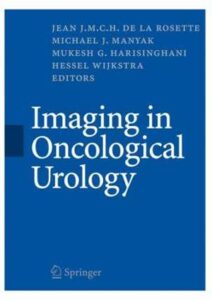نام کتاب: Imaging In Oncological Urology
نویسنده: G. Alivizatos و Jean J.M.C.H. De La Rosette و Michael J. Manyak و Mukesh G. Harisinghani و Hessel Wijkstra
ویرایش: ۱
سال انتشار: ۲۰۰۹
کد ISBN کتاب: ۱۸۴۶۲۸۵۱۴۳,
فرمت: PDF
تعداد صفحه: ۴۴۳
حجم کتاب: ۶۳ مگابایت
کیفیت کتاب: OCR
انتشارات: Springer-Verlag London
Description About Book Imaging In Oncological Urology From Amazon
Thepastdecadehasseendramaticadvances inurologyandimaging. Thesechangesareevident in improvements in laparoscopic surgery as well as in the emergence of multidetector CT, with multiplanar reformatting and FDG-PET-CT as routine imaging methods. The new minimally invasive procedures often require more exacting imaging as the surgeon does not have the same visual ?eld of view as was possible with open procedures. Thus, it is appropriate now to p- vide an update on imaging advances for the bene?t of urologists and radiologists alike. The increasing number of innovative imaging approaches to urologic tumors including CT, MRI, PET, SPECT, and endoscopic imaging can be perplexing and lead to over- and underesti- tions of the capabilities of modern imaging on the part of those who interpret them and those who use the information they provide for patient management. There is a growing “exp- tations gap” between what is expected and what is possible that needs to be closed. While previous books have focused on the more common urologic tumors such as bladder, prostate, andkidneycancer,nonehasattemptedacomprehensivereviewofthestateoftheartofimaging in most of the tumors involved in urologic oncology. Imaging in Urologic Oncology addresses these challenges. In the modern imaging department it is easy to forget how useful conventional plain rad- graphy can be in urologic diagnosis. Much of our current understanding of urologic disease is based on the “classic appearance” on intravenous urograms, cystograms, or retrograde pye- grams. Therefore, conventional imaging provides the ?rst “layer” in our understanding of u- logic tumors. The next layer is cross-sectional imaging.
درباره کتاب Imaging In Oncological Urology ترجمه شده از گوگل
این گذشته به پیشرفتهای عصبی و تصویربرداری در حال پیشرفت است. این تغییرات در بهبود جراحی لاپاراسکوپی و همچنین ظهور CT چند آشکار ، با تغییر شکل چند پلان و FDG-PET-CT به عنوان روشهای معمول تصویربرداری مشهود است. روشهای جدید با حداقل تهاجم اغلب به تصویربرداری دقیق تری نیاز دارند زیرا جراح از نظر بصری همانطور که در روشهای باز امکان پذیر بود ، ندارد. بنابراین ، اکنون مناسب است که از پیشرفتهای تصویربرداری برای منافع اورولوژیستها و رادیولوژیستها به طور همزمان اطلاع رسانی شود. تعداد روزافزون رویکردهای تصویربرداری نوآورانه در مورد تومورهای اورولوژیک از جمله CT ، MRI ، PET ، SPECT و تصویربرداری آندوسکوپی می تواند گیج کننده باشد و منجر به بیش از حد و نادیده گرفتن توانایی های تصویربرداری مدرن از طرف کسانی که آنها را تفسیر می کنند و که از اطلاعات ارائه شده برای مدیریت بیمار استفاده می کنند. بین شکاف بین آنچه که انتظار می رود و آنچه ممکن است باید بسته شود ، “شکاف توجیهی” رو به افزایش است. در حالی که کتابهای قبلی بر روی شایع ترین تومورهای اورولوژیک مانند مثانه ، پروستات و سرطان کلیه متمرکز شده اند ، هیچ تصمیمی در مورد تصویربرداری سریع در بیشتر تومورهای درگیر در سرطان شناسی اورولوژی انجام نشده است. تصویربرداری در اورولوژی اورکولوژی این چالش ها را برطرف می کند. در بخش تصویربرداری مدرن به راحتی می توان فراموش کرد که رادیوگرافی معمولی چقدر می تواند در تشخیص اورولوژی مفید باشد. بیشتر درک فعلی ما از بیماری های اورولوژیک بر اساس “ظاهر کلاسیک” بر روی اوروگرام های داخل وریدی ، سیستوگرام ها یا رنگدانه های برگشتی است. بنابراین ، تصویربرداری معمولی اولین لایه را در درک ما از تومورهای منطقی ارائه می دهد. لایه بعدی تصویربرداری مقطعی است.
[box type=”info”]![]() جهت دسترسی به توضیحات این کتاب در Amazon اینجا کلیک کنید.
جهت دسترسی به توضیحات این کتاب در Amazon اینجا کلیک کنید.![]() در صورت خراب بودن لینک کتاب، در قسمت نظرات همین مطلب گزارش دهید.
در صورت خراب بودن لینک کتاب، در قسمت نظرات همین مطلب گزارش دهید.

